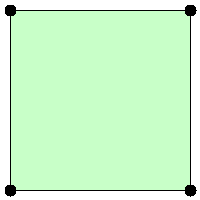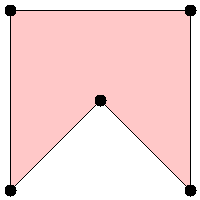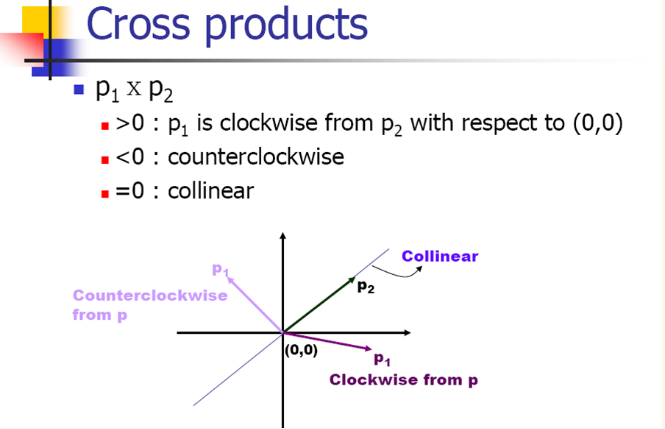469. Convex Polygon
Given a list of points that form a polygon when joined sequentially, find if this polygon is convex (Convex polygon definition).
Note:
- There are at least 3 and at most 10,000 points.
- Coordinates are in the range -10,000 to 10,000.
- You may assume the polygon formed by given points is always a simple polygon (Simple polygon definition). In other words, we ensure that exactly two edges intersect at each vertex, and that edges otherwise don't intersect each other。
- Example 1:
-
[[0,0],[0,1],[1,1],[1,0]] Answer: True Explanation:

Example 2:
[[0,0],[0,10],[10,10],[10,0],[5,5]] Answer: False Explanation:

分析:
只需按逆时针一次判断一边和一点的关系,若叉积>0,则表示存在大于180的内角,即为凹多边形。
对于任意两点组成的直线,第3点相对于这条直线都有3种关系,在线上,在线的左边,在线的右边。如果一个多边形是凸的,则对于多边形的任意一条边,其他的n-2个点必定都在边的同一侧。
假设有两点A(a[0],a[1]),B(b[0],b[1]),则直线AB的表示:(y-a[1])/(x-a[0])=(b[1]-a[1])/(b[0]-a[0])。对于任意点C(c[0],c[1]),要判断点C相对于直线AB的关系,将x=c[0]带入,y=(b[1]-a[1])/(b[0]-a[0])*(c[0]-a[0])+a[1];则y-c[1]=(b[1]-a[1])/(b[0]-a[0])*(c[0]-a[0])+a[1]-c[1];化简,判断符号。如果为正,说明,点C在直线AB的上边,为负在直线的下边,=0表示在直线上。
class Solution {
int judge_side(vector<int>& a,vector<int> & b,vector<int> & c)//判断点与线的相对位置
{
int ans = (a[1]-b[1])*c[0]-c[1]*(a[0]-b[0])+a[0]*b[1]-a[1]*b[0];
return ans==0?0:ans<0?-1:1;
}
public:
bool isConvex(vector<vector<int>>& points) {
int n=points.size();
int i;
int turn=0,next=0;
for(i=0;i<n;i++)
{
next=judge_side(points[i],points[(i+1)%n],points[(i+2)%n]);
if(turn&&next&&next!=turn) return 0;
turn=next;
}
return 1;
}
};更新:因为增加了新的测试用例:针对上一次的角度恰好是180度的情形.
class Solution {
int judge_side(vector<int>& a,vector<int> & b,vector<int> & c)//判断点与线的相对位置
{
int ans = (a[1]-b[1])*c[0]-c[1]*(a[0]-b[0])+a[0]*b[1]-a[1]*b[0];
return ans==0?0:ans<0?-1:1;
}
public:
bool isConvex(vector<vector<int>>& points) {
int n=points.size();
int i,j;
int turn=0,next=0;
for(i=0;i<n;i++)
{
next=judge_side(points[i],points[(i+1)%n],points[(i+2)%n]);
if(next)
{
if(turn*next<0) return 0;
turn=next;
}
}
return 1;
}
}; for example [[0,0],[0,1],[1,1],[2,1],[2,2],[2,3],[3,3],[3,0]]:




























 347
347

 被折叠的 条评论
为什么被折叠?
被折叠的 条评论
为什么被折叠?








